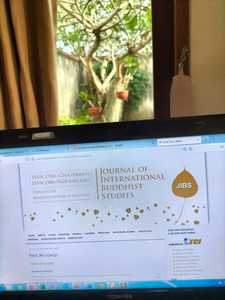Suamba, Ida Bagus Putu (2015) Cosmology and Cultural Ecology as Reflected in Borobudur Buddhist Temple. Journal of International Buddhist Studies, 6 (1). pp. 18-34. ISSN ISSN 1906-6244 (print) ISSN 2586-9620 (online)
This is the latest version of this item.
|
Text (Article)
176-771-1-PB.pdf - Published Version Download (1MB) |
||
![[img]](http://repository.pnb.ac.id/5635/3.hassmallThumbnailVersion/foto%20journal%20of%20buddhist%20studies.jpg)
|
Image (Foto Journal)
foto journal of buddhist studies.jpg - Cover Image Download (260kB) | Preview |
|
![[img]](http://repository.pnb.ac.id/5635/4.hassmallThumbnailVersion/foto%20daftar%20isi%20journal%20of%20buddhist%20studies.jpg)
|
Image (Daftar Isi)
foto daftar isi journal of buddhist studies.jpg - Cover Image Available under License Creative Commons Attribution Non-commercial Share Alike. Download (276kB) | Preview |
|
|
Text (Plagiarism Check)
13-Cosmology and Cultural Ecology as Reflected in Borobudur Buddhist Temple.pdf - Supplemental Material Available under License Creative Commons Attribution Non-commercial Share Alike. Download (3MB) |
Abstract
Advancement in science and technology that has been achieved by human beings does not necessarily imply they are freed from environ- mental problems. Buddhism since the very beginning has been in harmony with nature; the Buddha was fond of nature; however, it is very little its sources speak about the interconnection between human and environment. The question of the significance of cultural ecology comes into promi- nent in these days as there has been increasing environmental problems happen. Borobudur Buddhist temple in Central Java contains some ideas or elements that can be used to cope with the problems mentioned. Interest- ingly, the whole body of the monument was inspired by the teachings of the Buddha and Buddhism in which the Causal Law having impetus in the theory dependent-origination (Pratyasamutpada) is reflected clearly in the reliefs of Mahakarmavibanggain Kamadhatubase level. For a better understanding of this law, the connection with cosmology in Mahayana Buddhism is discussed in brief. It is found that there are various natural elements were depicted and crafted by the artists in a high standard of art as the manifestations of the Buddha’s teachings. Amongst the natural elements depicted here, tree, plant, or forest are dominant elements, which appear almost in all reliefs either in the main walls or balustrade. The relatedness amongst the elements is shown beautifully in complex relationship amongst them, and this has moral, aesthetical, spiritual, and ecological messages that need to be known for spiritual ascendance.When the interaction amongst them should be accomplished it is required an ethical principle as how to maintain harmony with those natural elements, animals and human beings for a better world order and happy life.
| Item Type: | Article |
|---|---|
| Additional Information: | -Paper presented in the 6th International Buddhist Seminar on Cultural Ecology organized by the Buddhist Research Institute of Mahachulalongkornrajavidyalaya University, Ayutthaya, Chiangmai Campus, Chiangmai Province, Thailand on 15th to 16th of October 2014. -International Journal. |
| Subjects: | Agama dan Filsafat > Ilmu Filsafat Agama dan Filsafat > Ilmu Filsafat > Filsafat Lain Yang Belum Tercantum |
| Divisions: | Jurusan Administrasi Bisnis > Prodi D4 Manajemen Bisnis Internasional > Publikasi |
| Depositing User: | Ida Bagus Putu Suamba |
| Date Deposited: | 04 May 2023 02:59 |
| Last Modified: | 04 May 2023 02:59 |
| URI: | http://repository.pnb.ac.id/id/eprint/5635 |
Available Versions of this Item
- Cosmology and Cultural Ecology as Reflected in Borobudur Buddhist Temple. (deposited 04 May 2023 02:59) [Currently Displayed]
Actions (login required)
 |
View Item |

